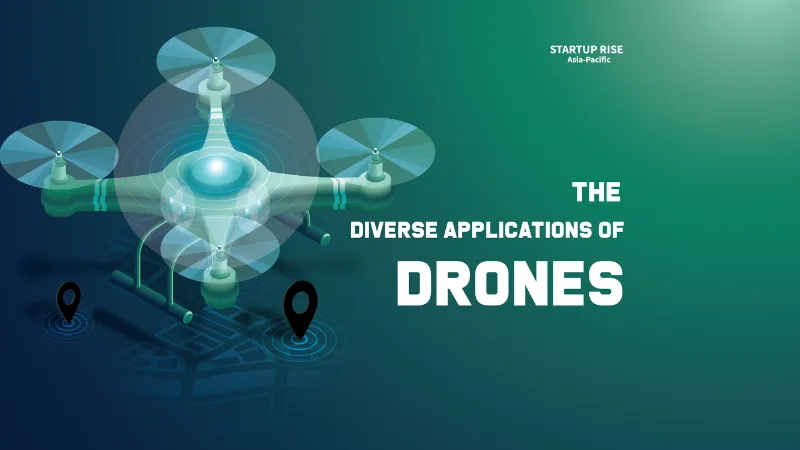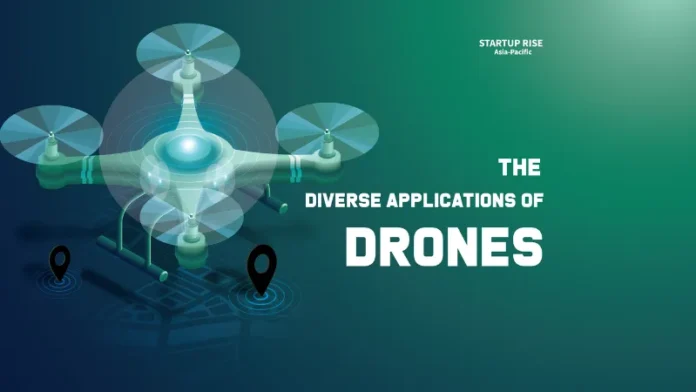
Drones, also known as uncrewed aerial vehicles (UAVs), are small aircraft that can be controlled remotely or fly autonomously. They come in various shapes and sizes, from small quadcopters to larger fixed-wing models. Drones are equipped with technology like cameras, sensors and GPS to perform a wide range of tasks across industries such as agriculture, photography and emergency services. Electric motors or internal combustion engines power drones. They are typically easy to deploy and operate.
The essential components of a drone include motors, propellers, flight controllers, batteries and remote control systems. The motors and propellers provide the lift the drone needs to fly while the flight controller processes data and controls its movements. The battery powers the drone’s electronics and the remote control system allows the operator to guide the drone. As drone technology continues to evolve, their use in various fields is expanding which is making them increasingly valuable tools for many applications.
What Do Drones Do?
Drones have numerous applications across many sectors due to their versatility, ability to access hard-to-reach places and capacity to collect real-time data.
Drones come in various types, each tailored for specific tasks, environments, and industries. Whether it’s carrying heavy payloads, covering long distances, or capturing high-resolution images, different drones are optimized for different purposes. Factors like flight stability, range, technology, and user-friendliness shape their design.
For example, quadcopter drones are great for photography, fixed-wing drones are excellent for long-range mapping and military drones are built for tactical operations.
Each type caters to unique needs in different sectors like agriculture, construction, racing, delivery and more. Drone designs equip the right tool for each job.
Uses of Drones
Table of Contents
Agriculture
The use of Drones is increasing in agriculture to monitor crops and improve farming practices. Drones used in agriculture are equipped with sensors and cameras. These drones can assess plant health by capturing images in different spectrums and identifying areas that need attention. It can also detect water leaks or dry spots which allows farmers to address irrigation issues more efficiently.
Drones also help with precision agriculture. It maps out fields and monitors growth patterns. It helps optimize crop yields and reduce waste. Drones can also monitor soil conditions and detect early signs of diseases or pests. Drones allow farmers to make more informed decisions and manage crops more effectively.
Construction and Infrastructure
Drones provide a cost-effective way to monitor project progress and improve safety in the construction and infrastructure industries. It can quickly capture aerial images of construction sites and provide real-time data for project managers. It also reduces the need for manual surveys. Drones can also be used to inspect hard-to-reach areas such as rooftops or tall structures and help in minimizing the risk of accidents.
Drone technology helps in detecting structural problems on construction sites early and prevents delays and repairs. Additionally, drones are useful for mapping the land and assessing the site before construction begins.
Environmental Protection
Drones play a crucial role in monitoring the environment and conservation measures. They are often used in the survey of wildlife populations, in tracking deforestation and monitoring ecosystems for signs of environmental stress.
Some drones also have thermal and infrared sensors to detect illegal activities like poaching, deforestation and unauthorized landfills. In some cases, drones are used to monitor pollution levels in rivers, lakes and oceans. It helps authorities track and address environmental hazards. Their ability to cover large areas quickly and provide detailed imagery makes them ideal for tasks that would be time-consuming or risky for humans. Drones provide a non-invasive way to gather critical data for environmental protection.
Emergency Services
The use of Drones is increasing in emergency response situations, especially in search and rescue operations. Drones help in quickly covering large areas and help rescuers find missing persons in difficult-to-reach places such as mountains, forests or disaster zones.
Some drones also have thermal and infrared sensors to detect illegal activities like poaching, deforestation, and unauthorized landfills. In some cases, drones monitor pollution levels in rivers, lakes and oceans. It helps authorities track and address environmental hazards. Their ability to cover large areas quickly and provide detailed imagery makes them ideal for tasks that would be time-consuming or risky for humans. Drones provide a non-invasive way to gather critical data for environmental protection.
Energy
Drones are increasing in emergency response situations, especially in search and rescue operations. Drones help quickly cover large areas and help rescuers find missing persons in difficult-to-reach places such as mountains, forests, or disaster zones.
Drones quickly survey large areas to detect issues like damaged power lines. It also helps identify leaks in pipelines and provides instant feedback to maintenance teams, which reduces the risk of accidents and helps speed up maintenance tasks. Some drones also have infrared cameras to detect temperature anomalies, such as overheating electrical equipment.
Manufacturing
Drones are becoming valuable tools for improving operations and efficiency in the manufacturing industry. Drones are being used in inventory management to fly through warehouses. They take stock of items and update inventory records in real time. It helps in reducing human error and keep track of large quantities of goods.
Drones assist in quality control in the manufacturing industry by inspecting products on assembly lines and spotting defects that humans miss. Drones also provide real-time data on shipments in supply chain management and help reduce delays.
Personal Use
Drones are already popular in areas like photography and videography. Photography and Videography drones are equipped with high-quality cameras, which allow us to capture high-quality footage from unique angles. These drones are popular for hobbyists, travel enthusiasts, and content creators.
Many drones offer advanced features like GPS tracking, obstacle avoidance, and automated flight patterns, which makes them easy for beginners to operate.
As drone technology becomes more affordable, personal use is expanding beyond just photography to include recreational flying and even racing.
Traffic Monitoring
Nowadays, Drones are being used to monitor and manage traffic. Drones used in managing traffic are equipped with tools that provide real-time aerial views of traffic flow and help authorities identify congestion, accidents and other road issues.
This aerial data allows city planners to adjust traffic signals or deploy resources more effectively to improve overall traffic management. Drones are also being used in tracking illegal parking, speeding vehicles and other traffic violations. They also provide evidence for enforcement. Drones help improve urban mobility and reduce traffic-related problems through traffic monitoring methods.
Weather Monitoring
Drones are playing a crucial role in weather prediction and monitoring. They can fly through different layers of the atmosphere with sensors and cameras and collect important data like temperature, humidity, wind speed and pressure. This helps meteorologists to get more precise and localized weather information, especially in places that are hard to reach, like oceans or mountains.
Drones also track critical weather events like hurricanes, tornadoes and thunderstorms. It provides real-time updates that help improve weather forecasts and give more accurate warnings to the public. By expanding data collection and enhancing real-time monitoring, drones are making a big contribution to weather research and prediction.
Conclusion
Drones are expected to transform various industries in the future. Drones will become more autonomous with the help of artificial intelligence (AI). It will make real-time decisions to avoid obstacles. In agriculture, they will assist with crop monitoring, precision planning and automated spraying. Drones will also play a crucial role in wildfire mitigation by tracking the spread and intensity of fires and even helping to put them out.
In supply chain operations, they will improve inventory management, identify defects and transport items. In healthcare, drones will enable faster delivery of medical supplies to remote areas. They will also be used in entertainment, with drone light shows improving concert performances and by law enforcement for surveillance and tracking suspects. The global drone market is projected to grow significantly, reaching 51.4 billion by 2027 and $91.3 billion by 2030.
FAQs
What is a drone, and how does it work?
Drones are unmanned aerial vehicles (UAVs) that are remotely controlled or operate autonomously. They work using a combination of sensors, GPS, onboard computers, and motors for flight control.
What are the main types of drones available today?
Common types include multi-rotor drones, fixed-wing drones, single-rotor helicopters, and hybrid VTOL (Vertical Take-Off and Landing) drones, each suited for specific tasks.
What industries use drones and for what purposes?
Drones are used across industries like agriculture (crop monitoring), construction (site inspection), photography (aerial shots), logistics (package delivery), and defense (surveillance and reconnaissance).
Are drones difficult to operate for beginners?
Many consumer drones are beginner-friendly with features like auto take-off, GPS stabilization, and obstacle avoidance, making them easy to fly.





